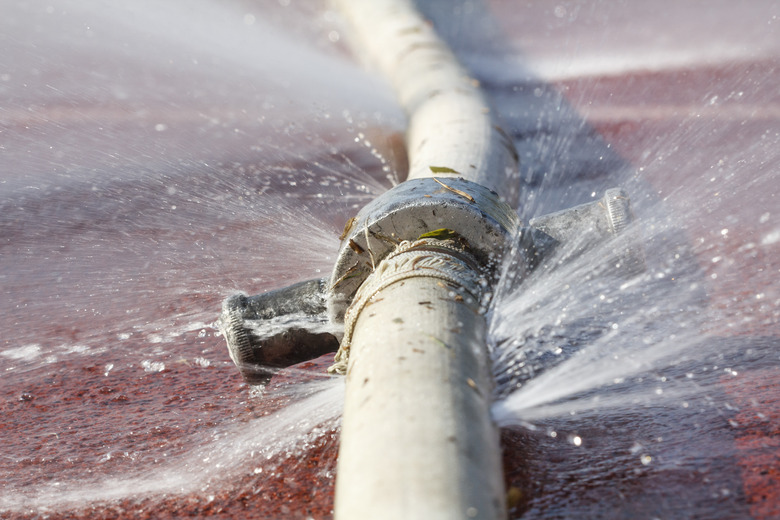How To Calculate The Fluid Flow Through A Hole In A Pipe
A common problem with pipes is corrosion. Over time, corrosion in a pipe can make a hole that causes a leak. Calculating the fluid flow through a hole can be difficult, due to many variables like fluid flow velocity, pressure in the pipe and density of the fluid, just to name a few, but don't get discouraged. You can find the answer you need by following a simple series of steps.
Step 1: Collect Measurements of the Pipe
Step 1: Collect Measurements of the Pipe
Obtain measurements: diameter (D) of the hole in the pipe and height (h) of the surface of the fluid above the hole. Make sure all measurements are in the same standard unit. For example, 1 inch = 0.0254 meters, so if you use inches, convert your measurements to metric units.
Step 2: Determine the Cross-Sectional Area
Step 2: Determine the Cross-Sectional Area
Calculate the cross-sectional area of the hole (A). Divide the diameter of the hole in half to get the radius. Use the formula:
\(A=\pi r^2\)
The result will be in square length units.
Step 3: Find the Fluid Velocity
Step 3: Find the Fluid Velocity
Use the Bernoulli equation to find the fluid velocity (v) if it is not already provided. If the fluid pressure in a pipe is constant (i.e., if the flow is steady), the fluid leaves through the hole in the pipe at a velocity of:
\(v=\sqrt{2gh}\)
where g is acceleration due to gravity, 9.8 m/s2.
Step 4: Find the Fluid Volume Flow (Flux)
Step 4: Find the Fluid Volume Flow (Flux)
Multiply the cross-sectional area of the hole by the fluid velocity to find the volume flow rate of the fluid (Q)::
\(Q=Av\)
This will be the volume of the fluid that leaves the hole in cubic meters per second.
Sample Calculation
Sample Calculation
Let's look at an example with numbers. Calculate fluid flow through the hole in the pipe with constant pressure if the water leaves the hole with a velocity of 1.7 m/s and the diameter of the hole is d = 1 inch = 0.0254 meters.
First, find the cross-sectional area of the hole:
\(A=\pi \times(0.0254/2)^2=0.00051\text{ m}^2\)
Since the pressure is constant and the velocity of the water going through the hole is 1.7 m/s, use the formula from Step 4 to find the volume of water that leaves the hole:
\(Q=0.00051\times 1.7 = 0.000867\text{ m}^3\text{/s}\)
Since 1 cubic meter = 61,024 cubic inches, Q = 52.9 inch3/s. Thus, 52.9 cubic inches of water leaves the hole in the pipe per second.
Things Needed
- Scientific calculator
- Tape measure
- Pen/pencil
- Paper
References
Cite This Article
MLA
Kambak, J.R.. "How To Calculate The Fluid Flow Through A Hole In A Pipe" sciencing.com, https://www.sciencing.com/calculate-flow-through-hole-pipe-5885513/. 13 December 2020.
APA
Kambak, J.R.. (2020, December 13). How To Calculate The Fluid Flow Through A Hole In A Pipe. sciencing.com. Retrieved from https://www.sciencing.com/calculate-flow-through-hole-pipe-5885513/
Chicago
Kambak, J.R.. How To Calculate The Fluid Flow Through A Hole In A Pipe last modified March 24, 2022. https://www.sciencing.com/calculate-flow-through-hole-pipe-5885513/
